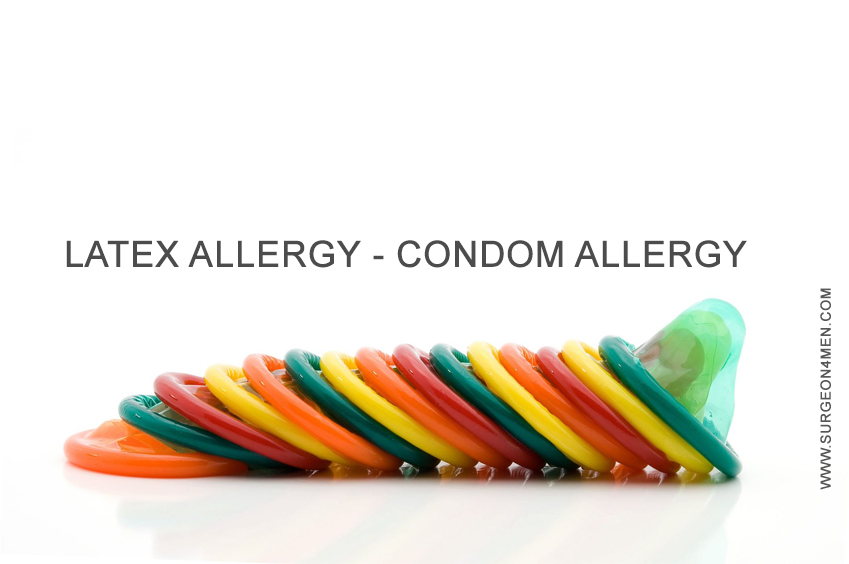Latex Allergy – Condom Allergy
Latex is a substance derived from the rubber plant and is used for manufacturing various household products like rubber bands, sole of shoes, rubber toys and balloons. Latex is also used for making condoms.
Certain individuals are sensitive to the proteins present in latex and may develop allergic reaction when they come in contact with it. It is believed that one to six percent of the US population is allergic to latex.
Type of allergic reactions to latex
There are two major types of reaction to latex. They are:
- Type I allergic reaction, better known as anaphylaxis. This type of reaction is characterized by sudden fall in blood pressure which may even be fatal is not addressed urgently.
- Type IV allergic reaction better known a delayed hypersensitivity. This type of reaction develops on prolonged or repeated contact with latex and is characterized by itching, skin rashes and hives.
Symptoms of latex allergy
The symptoms of anaphylaxis include:
- Sudden fall in blood pressure
- Tightness around the chest
- Labored breathing
- Nausea and vomiting
- Slurred speech

- Cold, clammy skin
- Rapid and shallow pulse
- Wheeze
Symptoms of delayed hypersensitivity include:
- Itching
- Running nose
- Watering of eyes
- Skin rashes
- Sneezing
- Coughing
In case of allergy to condoms made of latex, following symptoms are usually observed:
- Burning sensation: This may be observed on the shaft of the penis, inside the vagina or any other body part that has come in contact with the condom,
- Development of rash: The rash usually appears within eight hours of coming in contact with the latex condoms. The rash is pink or red in color, itchy and burns on touching. When scratched, the skin of the affected area may flake.
- Itching: This symptom can be very embarrassing. The entire genital area may itch. If a woman has engaged in oral sex, she may experience itching on her mouth and around the throat.
- Blisters: Repeated exposure to latex condoms may lead to blister formation on the affected part. These blisters are filled with water and may be extremely painful.
Treatment of latex condom allergy
 Before starting treatment, it is important to find out if the person is allergic to latex or the lubricant used in condoms. This can be found out by switching the brand of condoms. If it is found that the culprit behind the allergic reaction is latex in the condom, the patient can opt for condoms that are not made up of latex. These synthetic condoms are available in the market, although they are more expensive. One such synthetic condom is the one made up of polyurethane. It isbelieved that polyurethane condoms are thinner and are more effective in conducting body heat. Therefore they provide heightened sexual pleasure as compared to latex condoms. However, they tend to break more easily. Therefore, they are not as effective in preventing pregnancy and sexually transmitted diseases.
Before starting treatment, it is important to find out if the person is allergic to latex or the lubricant used in condoms. This can be found out by switching the brand of condoms. If it is found that the culprit behind the allergic reaction is latex in the condom, the patient can opt for condoms that are not made up of latex. These synthetic condoms are available in the market, although they are more expensive. One such synthetic condom is the one made up of polyurethane. It isbelieved that polyurethane condoms are thinner and are more effective in conducting body heat. Therefore they provide heightened sexual pleasure as compared to latex condoms. However, they tend to break more easily. Therefore, they are not as effective in preventing pregnancy and sexually transmitted diseases.
Natural skin condoms made up of lambskin are also available in the market. However, they are too porous to prevent the spread of sexually transmitted diseases.
Women who are allergic to latex condoms can opt for other methods of birth control like pills and IUDs. But again, barrier contraceptive is most effective against spread of STDs.
Anaphylactic reaction on exposure to latex is a medical emergency. Epinephrine injection, when given immediately, can prove to be life-saving.
Reference:
http://emedicine.medscape.com/article/756632-overview

